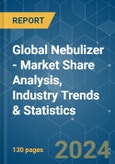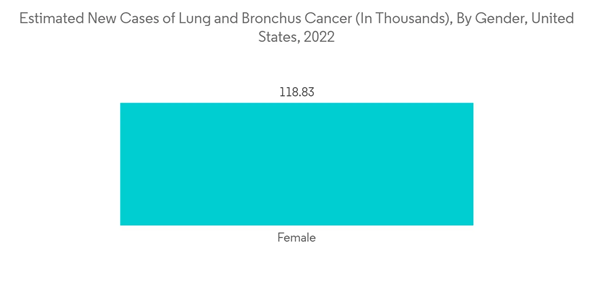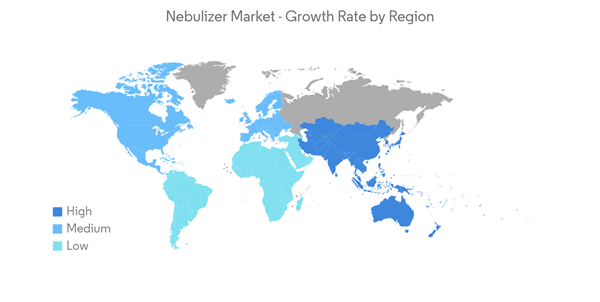The Global Nebulizer Market size is estimated at USD 2.14 billion in 2024, and is expected to reach USD 3.06 billion by 2029, growing at a CAGR of 7.48% during the forecast period (2024-2029).
The COVID-19 pandemic had a significant impact on the nebulizer market globally. The article titled "Impact of COVID-19 on people with asthma: a mixed methods analysis from a UK-wide survey" published in January 2022 stated that there was an increased inhaler use and worse asthma management in patients with COVID-19, compared with those not reporting COVID-19. Moreover, the article published in PubMed Central under the title "Guidance on nebulization during the current COVID-19 pandemic" in January 2021 stated that patients were hesitant about utilizing inhalation drugs that were thought to be possible sources of viral transmission and immunosuppression because they were aware of the possibility of airborne transmission of SARS-CoV-2. Patients with asthma or chronic obstructive pulmonary disease (COPD), however, should continue taking all inhaled drugs as directed. While some researchers do not rule out the possibility that nebulizer treatments may increase the risk of infection transmission via droplet nuclei and aerosols, it appears that inhalers, including pressurized metered-dose inhalers (pMDI), dry powder inhalers (DPI), or soft mist inhalers (SMIs), have a low risk of contamination. Thus, COVID-19 had a notable impact on the nebulizer market.
Certain factors are driving the market growth, which includes rising incidences of chronic respiratory diseases, increasing demand for home healthcare devices, and a rising geriatric population base. Tobacco smoking is one of the primary causes of the increase in respiratory diseases worldwide. As per the World Health Organization, May 2022 update, in 2020, 22.3% of people worldwide used tobacco, of which 36.7% reported were men and 7.8% reported were women. Additionally, the substantial increase in the prevalence and incidence of asthma has led to an increase in the patient population. For instance, as per the data from national and state surveillance systems administered by the Centers for Disease Control and Prevention (CDC), in May 2022, the prevalence of asthma was 25,257,138 in 2020. Furthermore, the American Cancer Society estimated that lung and bronchus cancer incidence in the United States in 2022 was 236,740. Such a high burden of lung cancer, asthma, and other respiratory diseases creates a need for nebulizers and hence drives the growth of the market.
Additionally, the launch of technically advanced nebulizers in different parts of the world is also propelling the growth of the market. For instance, in December 2020, AireHealth received 510(k) clearance from the United States Food and Drug Administration (FDA) for its connected nebulizer branded as VitalMed. The device is a portable, electronic vibrating mesh nebulizer designed to nebulize liquid medications for inhalation by a patient in and out of the home. Such approvals are propelling the growth of the market.
Thus, owing to the abovementioned factors, the market is expected to project growth over the forecast period. However, drug loss during drug delivery is the major restraining factor for the market studied.
The substantial increase in prevalence and incidence of asthma has led to an increase in the patient population, which has, in turn, increased the demand for these drugs. According to the World Health Organization (WHO) 2021 factsheet, asthma is a major noncommunicable disease (NCD) affecting children and adults. According to the same source, asthma affected approximately 262 million people worldwide. Thus, such a high burden of asthma creates the need for the jet nebulizer for the treatment and thus drives the growth of the segment.
Moreover, the rising adoption of jet nebulizers over ultrasound nebulizers is due to their convenience and cost-effectiveness compared to ultrasound nebulizers, which is expected to influence the segment's growth positively. According to the November 2021 article from Healthline, ultrasonic nebulizers can't deliver certain COPD medications. However, all COPD medications can be delivered through jet nebulizers. Thus, the advantages of jet nebulizers also contribute to the growth of the segment.
Hence, owing to the above-mentioned factors, jet nebulizers are expected to boost market growth.
The United States is the largest market in the North American region. The burden of respiratory diseases, such as tuberculosis, COPD, and sleep apnea, is increasing in the United States, which is fueling the demand for nebulizers across the country. As per the National Asthma Prevalence 2020 by the Centers for Disease Control and Prevention (CDC), 25,257,138 people were affected by asthma in the United States, of which 4,226,659 were children aged less than 18 and 21,030,479 were adults aged above 18. Thus, such a high prevalence of asthma is expected to propel the growth of the market.
Moreover, several mergers, acquisitions, partnerships, and product launches by the market players also positively influence overall market growth. For example, in June 2020, Respira Technologies announced the launch of a pharmaceutical-focused commercial development program for its RespiRx drug-delivery device platform, which is a portable, handheld vibrating mesh nebulizer. Additionally, in June 2020, the company Renovion raised USD 8.1 million in funding for the clinical development of ARINA-1 (ascorbic acid), which is an experimental nebulizer therapy to clear mucus and reduce inflammation in people with non-cystic fibrosis bronchiectasis and cystic fibrosis.
Thus, the abovementioned factors are expected to boost the growth of the nebulizer market in North America.
This product will be delivered within 2 business days.
The COVID-19 pandemic had a significant impact on the nebulizer market globally. The article titled "Impact of COVID-19 on people with asthma: a mixed methods analysis from a UK-wide survey" published in January 2022 stated that there was an increased inhaler use and worse asthma management in patients with COVID-19, compared with those not reporting COVID-19. Moreover, the article published in PubMed Central under the title "Guidance on nebulization during the current COVID-19 pandemic" in January 2021 stated that patients were hesitant about utilizing inhalation drugs that were thought to be possible sources of viral transmission and immunosuppression because they were aware of the possibility of airborne transmission of SARS-CoV-2. Patients with asthma or chronic obstructive pulmonary disease (COPD), however, should continue taking all inhaled drugs as directed. While some researchers do not rule out the possibility that nebulizer treatments may increase the risk of infection transmission via droplet nuclei and aerosols, it appears that inhalers, including pressurized metered-dose inhalers (pMDI), dry powder inhalers (DPI), or soft mist inhalers (SMIs), have a low risk of contamination. Thus, COVID-19 had a notable impact on the nebulizer market.
Certain factors are driving the market growth, which includes rising incidences of chronic respiratory diseases, increasing demand for home healthcare devices, and a rising geriatric population base. Tobacco smoking is one of the primary causes of the increase in respiratory diseases worldwide. As per the World Health Organization, May 2022 update, in 2020, 22.3% of people worldwide used tobacco, of which 36.7% reported were men and 7.8% reported were women. Additionally, the substantial increase in the prevalence and incidence of asthma has led to an increase in the patient population. For instance, as per the data from national and state surveillance systems administered by the Centers for Disease Control and Prevention (CDC), in May 2022, the prevalence of asthma was 25,257,138 in 2020. Furthermore, the American Cancer Society estimated that lung and bronchus cancer incidence in the United States in 2022 was 236,740. Such a high burden of lung cancer, asthma, and other respiratory diseases creates a need for nebulizers and hence drives the growth of the market.
Additionally, the launch of technically advanced nebulizers in different parts of the world is also propelling the growth of the market. For instance, in December 2020, AireHealth received 510(k) clearance from the United States Food and Drug Administration (FDA) for its connected nebulizer branded as VitalMed. The device is a portable, electronic vibrating mesh nebulizer designed to nebulize liquid medications for inhalation by a patient in and out of the home. Such approvals are propelling the growth of the market.
Thus, owing to the abovementioned factors, the market is expected to project growth over the forecast period. However, drug loss during drug delivery is the major restraining factor for the market studied.
Nebulizer Market Trends
The Jet Nebulizer Segment is Expected to Hold a Significant Share Over the Forecast Period
A nebulizer changes medication from a liquid to a mist. Jet nebulizers use compressed gas to make an aerosol (tiny particles of medication in the air). A jet nebulizer is a machine that turns liquid medicine into a fine mist that a patient can breathe in through a face mask or mouthpiece. The major advantage of jet nebulizers is their effectiveness and requirement for only simple, tidal breathing. Moreover, in jet nebulizers, dose modification and dose compounding are possible.The substantial increase in prevalence and incidence of asthma has led to an increase in the patient population, which has, in turn, increased the demand for these drugs. According to the World Health Organization (WHO) 2021 factsheet, asthma is a major noncommunicable disease (NCD) affecting children and adults. According to the same source, asthma affected approximately 262 million people worldwide. Thus, such a high burden of asthma creates the need for the jet nebulizer for the treatment and thus drives the growth of the segment.
Moreover, the rising adoption of jet nebulizers over ultrasound nebulizers is due to their convenience and cost-effectiveness compared to ultrasound nebulizers, which is expected to influence the segment's growth positively. According to the November 2021 article from Healthline, ultrasonic nebulizers can't deliver certain COPD medications. However, all COPD medications can be delivered through jet nebulizers. Thus, the advantages of jet nebulizers also contribute to the growth of the segment.
Hence, owing to the above-mentioned factors, jet nebulizers are expected to boost market growth.
North America is Expected to Dominate the Market Over the Forecast Period
The North American nebulizer market is expected to grow due to continuous technological innovations in the field of nebulizers. As the population in the region follows a fast-moving lifestyle, patients are looking for more portable nebulizer devices that can be transferred easily in a time of need for patients with asthma and other airway diseases.The United States is the largest market in the North American region. The burden of respiratory diseases, such as tuberculosis, COPD, and sleep apnea, is increasing in the United States, which is fueling the demand for nebulizers across the country. As per the National Asthma Prevalence 2020 by the Centers for Disease Control and Prevention (CDC), 25,257,138 people were affected by asthma in the United States, of which 4,226,659 were children aged less than 18 and 21,030,479 were adults aged above 18. Thus, such a high prevalence of asthma is expected to propel the growth of the market.
Moreover, several mergers, acquisitions, partnerships, and product launches by the market players also positively influence overall market growth. For example, in June 2020, Respira Technologies announced the launch of a pharmaceutical-focused commercial development program for its RespiRx drug-delivery device platform, which is a portable, handheld vibrating mesh nebulizer. Additionally, in June 2020, the company Renovion raised USD 8.1 million in funding for the clinical development of ARINA-1 (ascorbic acid), which is an experimental nebulizer therapy to clear mucus and reduce inflammation in people with non-cystic fibrosis bronchiectasis and cystic fibrosis.
Thus, the abovementioned factors are expected to boost the growth of the nebulizer market in North America.
Nebulizer Industry Overview
The nebulizer market is highly competitive and consists of several major players. In terms of market share, a few of the major players currently dominate the market. Various strategies, such as mergers and acquisitions, product approvals, and agreements, are being adopted by these key market players to increase the outreach of their products and strengthen their product portfolios. Some of the market players are Agilent Technologies, VYAIRE MEDICAL, INC, Drive DeVilbiss Healthcare, Rossmax International Ltd., and GF Health Products Inc., among others.Additional Benefits:
- The market estimate (ME) sheet in Excel format
- 3 months of analyst support
This product will be delivered within 2 business days.
Table of Contents
1 INTRODUCTION
4 MARKET DYNAMICS
5 MARKET SEGMENTATION (Market Size by Value - USD million)
6 COMPETITIVE LANDSCAPE
Companies Mentioned (Partial List)
A selection of companies mentioned in this report includes, but is not limited to:
- Agilent Technologies
- VYAIRE MEDICAL, INC
- Rossmax International Ltd.
- DeVilbiss Healthcare
- GF Health Products Inc.
- Invacare Corporation
- Koninklijke Philips NV
- Medline Industries Inc.
- Omron Corporation
- PARI Pharma
- Air Liquide Medical Systems
Methodology

LOADING...










